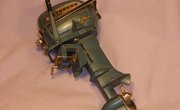Pull-rope or recoil starters are the most common method of cranking outboard motors of 25 horsepower (HP) or less. The rope is wound around a spring-loaded spool, and this spool provides a considerable mechanical advantage to help overcome the resistance to turning caused by the engine's compression strokes. When the rope is pulled and the spool rotated, a set of pawls extend from the spool's center and engage a cup that is fixed to the end of the crankshaft. This rotates the engine, drawing fresh fuel-air charges into the engine; this excites the ignition circuit and starts the engine. The pull rope is subject to chafing at the point that it enters the spool. Under the normal load of starting, the weakened rope can break, thus rendering the starter useless.
Items you will need
Set of tools
Replacement starter rope
Replacing a Starter Rope
Remove the screws or bolts that mount the recoil starter mechanism to the engine and pull the starter from the engine. Remove the broken rope pieces from the pull handle and the starter spool. Note the rotation direction of the spool as indicated by the old rope windings; also note the number of turns required to wind the entire pull rope around the spool.
Lay the two pieces of the old rope out and use it to determine the length of the new rope. Use braided rope for the replacement. Twisted and paper-core rope are not appropriate.
Wind the spool in the direction opposite the winding direction against the recoil spring and hold the spool firmly in position. Align the spool rope hole with the rope entry hole located in the spool cover. Do not back off the spool rotation to align it; instead, wind it tighter against the recoil spring to align the holes.This prevents loss of cranking rotation, reduces "bottom out" strain on the rope when it is pulled, and keeps the pull handle tight against the starter housing when at rest.
Thread the pull rope through the pull handle and tie a stopper knot (figure-eight knot) in the end of the rope where it exits the top of the pull handle. Thread the new rope through the holes in the housing and the spool. While still holding the spool in place (an extra pair of hands is useful at this point) against the recoil spring pressure, tie a stopper knot in the end of the pull rope at the end that is now inside the spool. Pull the slack from the rope and allow the knot to bottom out against the spool hole. Slowly release the spool and allow the recoil spring to wind the new pull rope around the spool until it draws the pull handle tightly against the starter housing.
Reinstall the starter mechanism onto the engine and torque all of the mounting screws. Test-start the engine to insure that the starter works properly and recovers the pull rope fully.
Warnings
- The replacement rope should be identical in diameter to the original rope and of similar flexibilit; if it's not, rope bind may occur and interfere with smooth starter operation. Natural fiber (hemp, cotton) rope reinforced with synthetics provide the best wear resistance and flexibility. Avoid full synthetics such as polypropylene--they are extremely susceptible to chafing, heat and ultraviolet (UV) damage.
References
Warnings
- The replacement rope should be identical in diameter to the original rope and of similar flexibilit; if it's not, rope bind may occur and interfere with smooth starter operation. Natural fiber (hemp, cotton) rope reinforced with synthetics provide the best wear resistance and flexibility. Avoid full synthetics such as polypropylene--they are extremely susceptible to chafing, heat and ultraviolet (UV) damage.



